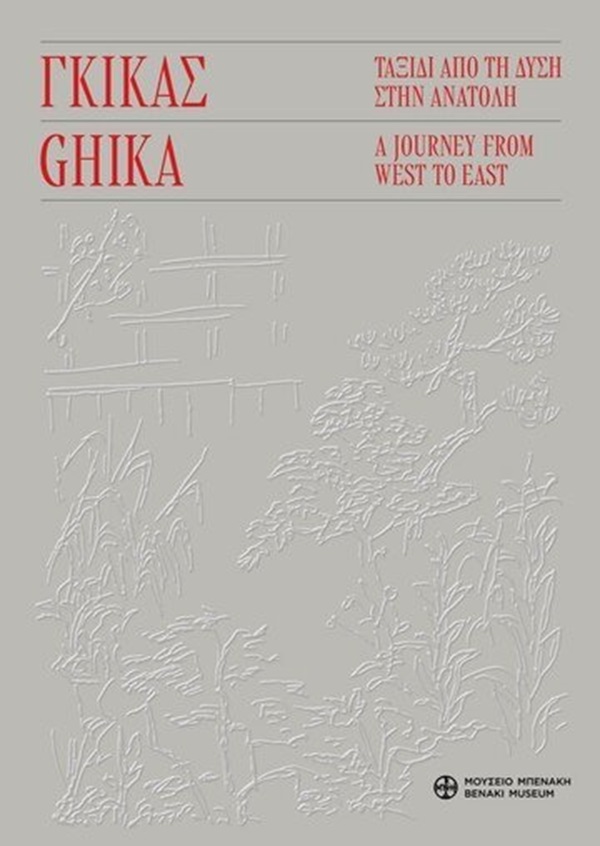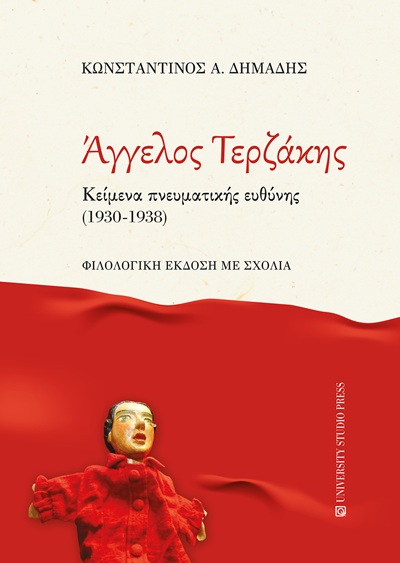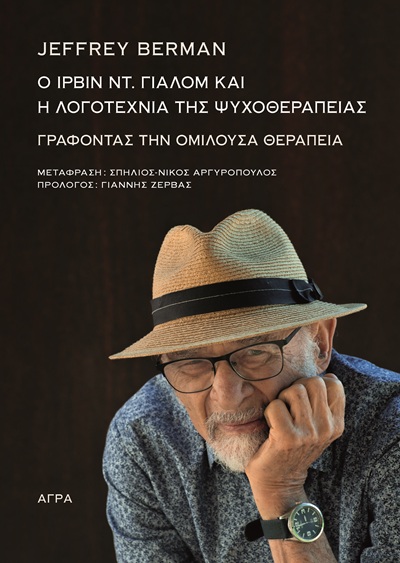
Title: Ghika: A Journey from West to East
Edited by: Ioanna Moraiti
Publisher: Benaki Museum
Subject: Exhibition Catalogue
Year: 2024
Pages: 350
Τechnical Features: 21×28,5
Serene Buddhas, architectural gardens and a great love captivate the reader as he flips through the left-hand “ear” of the publication. Drawings and letters are addressed to a strong love and, soon after, fellow traveler on the great journey from west to east, and to life, Barbara Warner.
In his prologue, the scientific director of the Benaki Museum, George Manginis, introduces us to Gikas’s aesthetic preferences from the early years of his involvement with art. The artist, although belonging to the famous generation of the ’30s, followed his own aesthetic path, avoiding the study of Greek artistic production of the previous century, as his contemporaries, also mainly educated in Paris, do. As he says, ‘The preference for the Far East must be linked not only to the artist’s personal sensibilities (he loved drawing meticulously and at the same time could theorize the slightest touch) but also to the spirituality of Eastern philosophical systems that emanated from textual traditions‘.
Ioanna Moraiti, curator of the Ghika archive and gallery, introduces us to the cognitive and aesthetic travel universe that the artist follows after an invitation from the American Ambassador in Athens, V.Allen, to participate in an international educational programme sponsored by the American government. Arriving in America, he met important intellectuals of the time, such as Antony Clark, Eduard Fenton, Muriel King and Francois Tueffer.
From his stay in New Orleans, he would distinguish in the French Quarter “the lace balconies” motifs that had previously occupied his work in Athenian neighbourhoods.
From his visit to Mexico he will be impressed by the art of the Zapotecs and the Aztecs to such an extent that he will characterize Mexican folk art as “comparable to Greek art or even richer“. He will note their stone mosaics and architectural motifs. An exponent of architecture and decoration himself, which is also evident in his house on Kriezotou Street (note: Benaki Museum / Ghika Gallery), he points out to architect D. Pikionis his excitement, from the exhibition of Mexican art at the 1952 Paris exhibition, about the oxymoron of a completely separate and different art highly remarkable to be supported by a people with wild instincts and yet so authentic and so creative.
After Mexico to Texas, New Mexico, Santa Fe, Grand Canyon, Arizona , Los Angeles, California, San Francisco, Hawaii, Honolulu, California, San Francisco, Hawaii, Honolulu from where they will depart for the Far East. The images are now familiar to us through pictures and films of the time. What is remarkable is that Ghika and his companion enjoyed in each city the hospitality of the most famous intellectuals, artists and architects of the time as citizens of the world, as if the mileage and travel difficulties of the time created no barrier to communication and deep friendship.
In 1956, two years before Ghika’s trip to the Far East, the 2500th anniversary of Buddhism was celebrated. Gikas articulates the harmonious blending of Greek art with Indian art and the blending of Japanese art in representations of the Buddha, a blending evident in Daibutsu, the great Buddha of Kamakura. The artist’s particular interests always included ancient tragedy “where he believed that performances should remain faithful to the ancient model mainly through the use of masks” and he believed in the comparative study of cultures ,recognizing many affinities in theatre and dance, especially in terms of origins which are religious, the sacred space of performance, architecture and decoration. These observations form a large part of the drawings he brought back from his trip to the Far East. Influences from Greek ancient drama in expression and dance will also be noted in Indian dance and more specifically in the “Kathakali” school.
N. Ghika refers to Chinese culture as analogous to ancient Greek culture, “mainly in the analogy between the highest creations of art and the most ordinary objects of everyday use”. A profound student of Chinese iconography, he says in a letter to D. Pikionis, after visiting the permanent exhibition at the Guiet Museum with exhibits of 14th-century China, that he finds in Chinese art “a creative ability that is hardly surpassed, at least as regards variety of forms and refinement …..n the art of Japan and China nothing is pressed or weighed down”. On the trip to Japan they meet important figures of the Japanese intellectual and artistic era such as architect Kenzo Tange, sculptor Isamu Noguchi, dancer-choreographer Michio Ito, and visit the National Museum of Western Art built by Le Corbusier.
On 25 July they leave by train for Kyoto. He expresses a keen interest in the architecture and gardens of Japan. In total they visit over 30 temples and temples. He specifically states ‘The destination of the gardens was aesthetic pleasure, concentration and deep contemplation away from the mundane’. In his lectures he will highlight the Japanese home as a model, stating that simplicity, austerity, exquisite proportions and sensitivity in the choice of materials make the Japanese home one of a kind. The same qualities are found in the gardens of Japan.
On August 19 they arrive in Hong Kong.They visit the Man Mo temple dedicated to the god of literature Man and the god of war Mo. They visit local markets and Ghika will become a collector of tea bowls and snuff bottles, for which he will create a special place in his house on Kriezotou Street. They continue their journey to Thailand ,Bangkok, Cambodia, Laos, Bangkok, Cambodia, Laos, Burka. About his trip to India he writes “here the Reason does not apply, but the mystery of the initial and incessantly repeated sacrifice , the agony of the impossible escape” obviously referring to the impenetrable caste socio-economic system, of a religious nature. His experience was so overwhelming that he would write a 17 handwritten page text about his journey to India, material which he published in Greek English with a translation by Patrick Leigh Fermor, together with drawings mainly in shinny ink in the Japanese “sumi” method.
They start from Kolkata and travel to Patna, Nepal, Benares, New Delhi, Jaipur, Mumbai, Aurangabad and continue to Kadmandun, Patan and Bhaktapur where Gikas will be impressed by the Newar architecture with distinct elements of wood and brick. His experience will produce one of his most interesting paintings dedicated to the Dubar Pasan Square in Kathmandu. Ghika is also fascinated by the country’s mythological animals such as the griffin, chimera etc., elements that are also found in his visual approaches to theatre performances even before his trip. At the Ganges River in the town of Bekaral they will learn about the sacred customs of the country and its rich architecture. In picturesque Jaipur, Ghika will be impressed by the colourful costumes and rich ornaments of the women.
On 28 September they start their return journey to Greece.They will stop for an hour in Cairo where they will visit the Egyptian Museum. The artist’s great fondness for Egyptian art has been recorded in texts and drawings since 1942. On his return to Athens he will bring about 100 drawings from the trip .
The trip gave the artist images and new habits in his daily life. The Chinese cuisine, the tea chi gymnastics but above all a great love with whom he was going to share the rest of his life.
Anita Balkanas, Dr. History and curator of the National Museum of Contemporary Art, refers to the deep roots of the search for the universality of culture through the spirituality of the Far East, together with the co-founders of the 3rd Eye publication. On his return from Paris in 1934, he will join the so-called generation of the 30s along with Dimitris Pikionis, Spyros Papaloukas, Stratis Doukas, Socrates Karantinos, Takis Papatsonis, Michalis Tombros and Angel Theodorakopoulos. In the publication they defend eclecticism in art and authenticity in expression.
It refers to the artist’s anti-naruralist vision, with influences from the European avant-garde, Byzantine, folk art and Sino-Japanese art. Spiritual currents of the time such as “Pythagoreanism” come to inspire a series of artists of the time seeking the harmony of the universe through a deep spirituality promised by art and life in the countries of the Far East.
From the late 1930s, he “develops a Greek-centric discourse in which he encounters the timeless character of Greek art and Cubism”. In the work “Great Landscape of Hydra 1938 explosive points out metaphysical landscape perspectives that he recognizes in Far Eastern art as well as a perfect “all over” perspective that implies a multiply changing point of observation, and was for the Chinese a necessary condition and overall perception of the landscape”.
After the Second World War, it will again seek the markets of Europe. He will denounce 19th century painting and point out in a letter to D. Pikionis the “lack of purity”. During this period Gikas singled out the artists Braque, Gerges, Moualt and Picasso. Klee’s influences are also evident in his work during this period for which he publishes an article in Nea Estia. The gaze sees symbols.
Far Eastern influences are evident even when Ghika’s painting enters abstraction in 1955, before his trip in 1958. In addition to references to the calligraphic writing of the East, he incorporates the idea of “emptiness” and the cosmological dimension of Chinese and Japanese painting into his work.
After his journey, his painting language is expanded “enriched more systematically with new themes of arts, principles and law of Sino-Japanese art”, the chin yun senk dong, that is, the creation of a moving pictorial reality that conveys the vitality of the landscape. The Far East enriched his pictorial language without confining him to the strictness of its conventions. Mostly he balanced the “intellectual perspective of cubism with a more intuitive and emotional approach to nature”.
The paperback version is an editorial work. The influences of the Eastern typographic tradition are obvious, with the red threaded staples evident. On the left front cover is a 24-page feminised fine pale yellow paper, printed with blue and black lettering, sketches and cart – postals from the travel diary. On the inside back cover folds an expandable cover creating a second spine surface completing a “box” paper art object.
The publication comes to recall the unique experience of travel literature, when it is done by craftsmen storytellers, let alone when it is accompanied by unique aesthetic images printed and open







Leave A Comment